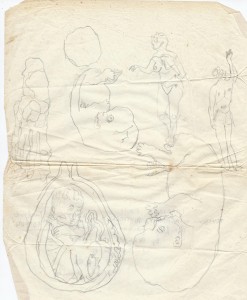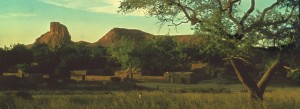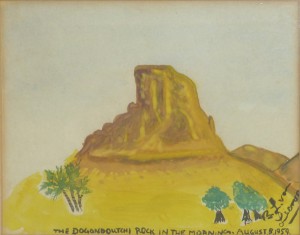This ‘Juvenilia’ page refers to a childhood decade, 1951-60. I mention this decade only as a preface to 1961-70, as it gives a few pointers to later efforts.
My earliest ‘drawings’, made in French West Africa, are tracings from my parents’ anatomy textbook from the Missionary School of Medicine, London. I can recall my childhood fascination with watching animal carcases being cut up at in our town’s market, a sight which seems to have started my life-long interest in anatomy, informed by medical textbooks.
Another favourite subject for my sister and me to draw was the camel-train of weathered rocks which we saw every morning from the front windows of our house.
After being sent to boarding school in Britain, my best Christmas present in 1955, was a good quality watercolour paint-box, given to me by a wealthy and cultured ‘Aunt Mimie’ from New York (in fact, an aunt of Dr George Kelly, one the temporary guardians of my sister and me). ‘Aunt Mimie’ had noticed my interest in drawing, and her generous present gave my intertest in art both practical and psychological encouragement.
I used this paintbox in the summer holidays of 1959, when my sister and I visited our parents and I attempted to paint the rock, which gave our town its name, Dogondoutchi,- (“Tall Rock” in Hausa). This obsession with ‘The Rock’ may have been a trigger for my later ‘obsessions’ with the topography of where I live. As we we walked through the town and looked up at the rock from different places, I was disturbed by the weakening of its usual heraldic profile when seen from our house. Perhaps this was an early response to sculptural form, albeit on a colossal scale.
Two years earlier, I was eleven, my sister and I had spent Easter in the Netherlands, after an invitation from our great uncle ‘Om Carl’ and ‘Tante Monnie’, his wife. He was a Lutheran minister in Deventer and my Dutch-American Grandmother’s youngest brother, who had been a missionary in Java and a prisoner of the Japanese. His extreme war experiences are recorded in his memoir (J. C. Hamel Soldatendominee, 1948, ‘S.Gravenhage, N. V. Uitgeverij W. Van Hoeve). He saw and praised drawing I had made of my left hand in a small sketchbook , and followed ‘Aunt Mimie’ in buying me a larger “Schitzenboek” to spur my enthusiasm. Om Carl owned original oil paintings and took us to the Rijksmuseum to see Rembrandt’s ‘Nightwatch’, re-inforcing the high status that Art enjoys in Dutch culture that we had begun to learn from his older sister, our grandmother, who had studied for a year in a Dutch Art Academy before emigrating to the US.
.



